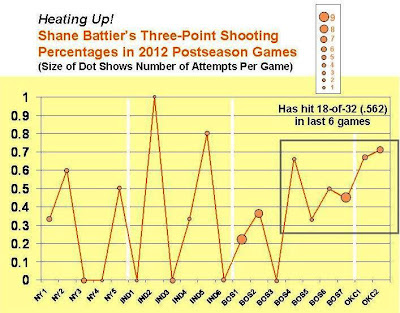With yesterday's series-concluding 3-0 loss to San Francisco by Los Angeles -- coming on the heels of 2-0 and 8-0 Dodger losses to the Giants -- the two teams are now tied for first place in the National League West. The Dodgers had led their northern California rival by eight games earlier this season. The Bay Area, on the whole, has not been kind to the Dodgers lately, as they were swept by the A's in Oakland June 19-21 by scores of 3-0, 4-1, and 4-1.
Going back to the Dodger-Giant series, however, the L.A. Times article on yesterday's game noted the following:
... the Dodgers have been held scoreless the last 30 consecutive innings. It was the first time the Los Angeles Dodgers had been shut out by one team in three consecutive regular-season games. The Brooklyn Dodgers suffered the same fate in 1937.
The Dodgers moved west in 1958, so the specific type of scoreless streak alluded to in the quote is unprecedented for 54 years. Note the important qualifier in the quote, however:
... the first time the Los Angeles Dodgers had been shut out by one team in three consecutive regular-season games...
This qualifier suggested to me that the Los Angeles-era Dodgers must have been blanked three straight at some point before this week, but involving more than one opponent (i.e., being shut out once or twice by one team to close out a series and then being shut out once or twice in a series against a new opponent). I thus perused Dodger game logs going back in time and found the following sequence in 2007:
Sun, Aug 5 vs Arizona L 3-0
Tue, Aug 7 @ Cincinnati L 4-0
Wed, Aug 8 @ Cincinnati L 1-0
There could well be additional three-game Dodger scoreless streaks against multiple opponents prior to 2007, of course. But even though a Dodger three-game runless streak may not be quite as rare as it originally seemed, there's no question the L.A. bats are quiet.
The most obvious reason would have to be the absence of Matt Kemp, who has played in only two games since May 13 due to hamstring problems. He had been going wild offensively before his injury. For those who prefer traditional baseball statistics, Kemp hit 12 home runs and recorded a .355 batting average before his extended absence; for those into sabermetrics, Kemp had compiled a stratospheric 1.163 OPS (On-base [.444] Plus Slugging [.719] percentages).
The absence of one player alone, presumably, would not be enough to quell the entire offense of a team that had been doing so well. I thus examined the monthly offensive output (again using OPS) for the five Dodgers with the most at-bats so far this season (which would not include Kemp). From ESPN.com's Dodger statistics page, you can click on a player's name and then click on "Splits" to see the monthly breakdowns. The following graph presents what I found.
Two players in particular, right-fielder Andre Ethier (who himself was injured in yesterday's series finale against the Giants) and catcher A.J. Ellis, were hitting at exceptionally torrid paces in April and (especially) May. An OPS around 1.000, which Ethier and Ellis reached in May, is very rare. Currently only four National Leaguers are above 1.000 for the season. As shown in the graph, Ethier and Ellis have now come down to the .600s thus far in June, well below each player's respective career OPS (Ethier, .843; Ellis, .766).Other Dodger players in the graph have either remained level or dipped slightly in their OPS from May to June.


